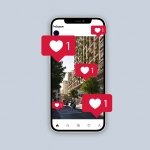— what’s hype, and what’s real
It’s easy to come across visions on how digitalization will revolutionize the real estate business. But which viewpoints are already affecting us, and which are to be considered inspiring prophecies of what’s to come? Let’s untangle three current tech trends; explain how they’re connected and what this has to do with you:
Metaverse
What is it?
There’s no established definition of the term metaverse, but it may be explained as something that emerges when digital 3D worlds become our primary means of interaction. Incomprehensible, much? Let’s try a more down-to-earth approach.
Metaverse consists of several digital worlds connected to one another. Imagine purchasing digital outfits for your FIFA players and using the same clothes on your 3D avatars when they visit a digital work meeting or go to a concert. Easily put: the digital world will become as real as the physical one.
Vision vs Reality
Depending on which definition is used, the visions are within different reaches. It will take years before we can seamlessly move between physical and virtual worlds, but already today there are digital realities that are central for many people. The game Fortnite is an example of this. It’s a survival game but also a platform in which players interact and build communities.
With all this said, it’s highly unclear whether the metaverse will even be called metaverse in the future. We might just say the internet.
Current Projects
Digital 3D worlds in which you can buy land and build virtual houses exist already today. Last year, the four biggest worlds turned over a total of 500 million dollars. There’s not much to do in these worlds today, but the investors hope that the value of their digital lands will increase once the vision of the metaverse becomes accessible to all. If you’re looking to invest, check out Sandbox – the biggest virtual world right now.
Digital Twins
What is it?
A digital twin is a digital copy of a physical object. It can be a machine, a building or a whole city.
Two parts are central for digital twins. One’s data from the physical object and the other is visualization. When it comes to buildings, the data is extracted from strategically placed sensors. By collecting and making the data viewable from a central database, it’s easier to optimize the function of the building as well as planning for long-term maintenance.
Vision vs Reality
The concept of digital twins is nothing new, but we’re far from the vision of a digital city in which all the buildings deliver real time data into a central virtual platform. The development speed on this depends to a great part on the development of other technical innovations, such as 5G sensors and machine learning algorithms.
However, bear in mind that it is yet to be decided how much data a house needs to generate in order to call its visualization a digital twin.
Current Projects
There are plenty of platforms that you can use to create digital twins, one of the most established being Microsoft’s Azure Digital Twins.
Virtual Tours
What is it?
Virtual tours are mainly used to display and market buildings and real estate. There are two types of techniques. You can use a 360 camera to create an exact copy of the construction, or you can create a virtual tour using Building Information Modeling (BIM).
Vision vs Reality
Contrary to metaverse and digital twins, virtual touring is already being used by architects and real estate developers. For people in real estate, the technique makes it possible to start selling spaces long before the building is done. Architects use virtual tours mainly to visualize complex propositions and thereby gain the buyer’s trust.
Current projects
When it comes to virtual tours of existing spaces, Matterport is the dominant player.
If you’re looking for exclusively digital tours, there are several options. One of the most advanced platforms is SpaceWalk. It focuses completely on photorealism. Here’s an extensive tour in which the visitor can move around in indoor as well as outdoor environments.
To sum it up:
The past years’ innovations, such as smartphones, social media and cloud computing, have matured. That places us in a time when people look ahead to find the next massive technical innovation. The big tech companies are currently investing billions to develop hardware and software that will make it possible to experience true to life 3D worlds.
The future of the metaverse will at a great part be defined by the progressiveness of these new techniques and how fast they can be developed. But one thing’s for sure. The digitalisation of the real estate business has only just begun, and 3D visualizations will be central to the movement.


